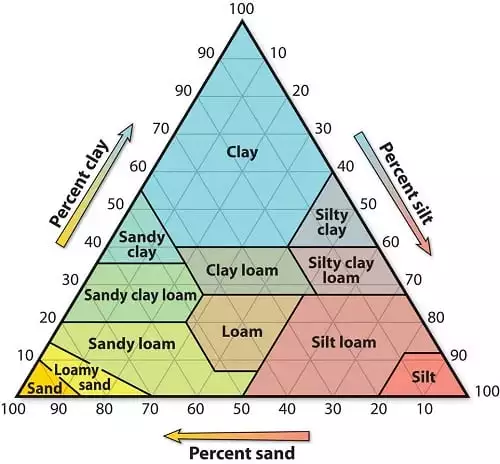The Basics of Soil
Soil performs the follow four basic functions for plant growth:
- Anchors the roots
- Supplies water to the plant
- Provides air for the plant roots
- Furnishes minerals for plant nutrition
Plants combine carbon dioxide from the air and water from the soil into sugar, other carbohydrates and protein through a process called photosynthesis. The plant roots then uptake nitrogen, sulfur, phosphorus and several other elements that are needed for essential plant functions. A typical plant is made up of about 80% water and 20% dry matter with the largest part of the dry matter being composed of hydrogen, oxygen, carbon, and nitrogen, while the rest consists of a great variety of elements that originate in the soil. In spite of the small amounts of these components, they are absolutely essential and the absence of only one of these elements makes plant growth impossible.

Soil Structure
Soil is typically made of four different particle classifications: gravel, sand, silt, and clay. The relative proportion of the various grain sizes determines its texture, described in classifications such as loamy and, silt loam, clay, etc. A soil’s texture is crucial in its ability to retain nutrients and water for plant uptake.
Loam soils generally contain more nutrients, moisture, and humus than sandy soils, have better drainage and infiltration of water and air than silt and clay-rich soils, and are easier to till than clay soils. Ideal soil type.
Sandy soils are best amended by adding compost. Clay soils are best amended by adding gypsum. It is important to do a soil test on your fields so a custom prescription of soil amendments can be recommended.
STRUCTURE PROS
- CLAY: Absorbs water, gas, and dissolved minerals. Rich in nutrients.
- SAND: Allows for percolation of unwanted substances
- SILT: Holds much water in the soil and most of this water is available for plant use. As silt breaks down, its release nutrients to the plant
STRUCTURE CONS
- CLAY: Need positive cation exchange to effectively release water and nutrients to become plant available. Too much clay restricts the roots ability to uptake water and nutrients.
- SAND: Does not adequately hold water and minerals for plant uptake
- SILT: Can easily compact and drains poorly. Although fairly fertile cannot hold as much nutrients as is ideal.
SUBMIT YOUR SOIL REPORT
Upload your soil report and our agronomists will evaluate to prescribe the perfect blend of amendments and nutrients for your particular need. Need to have a soil test done? Contact us to inquire about your custom soil test that will result in your soil report and recommendations for your field.
